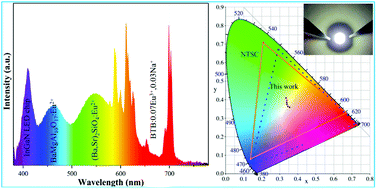Charge compensation engineering for high-performance dolomite-type BaTi(BO3)2:Eu3+ red-emitting phosphor for backlight display applications with a wide color gamut
Abstract
Exploiting high color purity phosphors is a core problem in the development of phosphor conversion light-emitting diodes (pc-LEDs) for display devices. Eu3+-activated BaTi(BO3)2 (BTB) red-emitting phosphors were first synthesized via a solid-state reaction at low temperature and alkali metal ions Na+ were co-doped in BTB:xEu3+ to improve the luminescence properties. The occupation of the Eu3+ ions and the enhancement principles of the Na+ ions and their effect on the photoluminescence properties of the BTB:xEu3+ phosphors are discussed in detail. The BTB:xEu3+,Na+ system demonstrated a strong thermal stability (68.4% at 150 °C), low color temperature (about 1940–1950 K) and high color purity (almost 90%). Furthermore, the prototype LED device can emit a bright white light, has a stable luminous efficiency and color rendering index, and the color gamut reaches 115.5% of the NTSC standard. Therefore, the BTB:xEu3+,Na+ series phosphors provide a better choice for the development of lighting and display devices with a wide color gamut.



 Please wait while we load your content...
Please wait while we load your content...